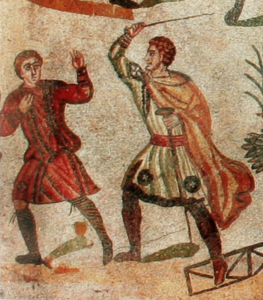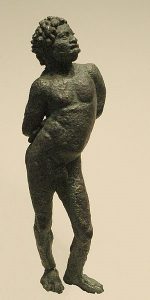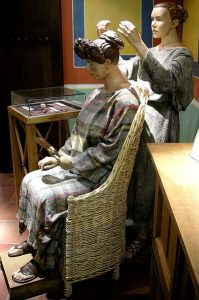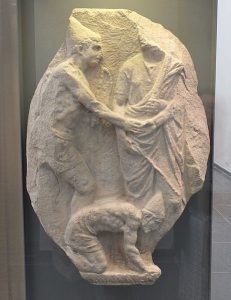This month’s post has been written by Harrison Kavanagh, a M.A. student in Ancient History at the University of Kent.
Like all of history’s great empires, the existence of the Roman Empire, and all its grandeur and dominance came at a great humanitarian cost. That the city was reportedly founded on the fratricide of Remus by his brother Romulus is revealing. A predilection for violence is visible all the way from Rome’s distant origins up to its eventual demise (Livy.1.7). In addition to the murder and forced subjugation of a countless number of people, one of Rome’s greatest crimes against humanity was the widespread practice of slavery. Enslaving people, owning and trading them, was integral to Rome’s economy as well as its social structure and thus it can undoubtedly be described as a “slave society”. Consequently, the topic of slavery in the Roman Empire has been one of interest to modern Roman historians. There is, however, a disconnect between the general reader’s interpretation of Roman slavery and its known realities. Here, I seek to highlight these common misconceptions and bring the true nature of slavery in Ancient Rome to the fore.
Slavery, for many civilisations throughout human history, has been an inescapable fact. The post-abolition world, however, almost unanimously views the practice as morally wrong. In Western discourse, the transatlantic slave trade is unavoidable when discussing slavery in both modern and ancient history (Alston 2011, 1). Consequently, the word “slavery” has become deeply associated with racism and beliefs of white supremacy. To understand slavery in other historical contexts, including the Roman period, it is necessary to challenge this assumption. Slavery, rather than being restricted to the owning and trading of people along racial lines, should be seen as a much wider concept.
Firstly, it should be said that providing an accurate breakdown of the diversity of Rome’s enslaved peoples is difficult. What one can say for certain is that the range of ethnic backgrounds evident in Roman life was reflected in slavery. Enslaved people could have come from as far as Britannia or the Balkans, or as near as the city of Rome itself (Bradley 1988, 478). In contrast to the transatlantic trade, there was a notable lack of racial distinction between enslaved person and master. Many Romans owned people of the same race as themselves (Bradley 1988, 477-478).
Figure 1: A master beating an enslaved person who appears to be of the same race.
The type of segregation produced by the transatlantic trade did not therefore exist (Bradley 1988, 478). Roman society had differing moral justifications of slavery from those of the transatlantic trade. Whilst enslaved people in the Roman period were, as in the transatlantic slave trade, viewed as socially and economically inferior to free citizens, they were not necessarily viewed as racially inferior (Watson 1987, 3).
It is important to state, however, that this does not mean racism was absent from Roman slavery. Black, Syrian and Jewish people are examples of groups who were heavily associated with slavery in Roman culture, and all enslaved people were often characterised as foreign and barbaric (Bradley 1988, 481).
Figure 2: 2nd-1st century BC Statue of an African enslaved person.
Some might see this as evidence that racism and slavery are indeed inseparable; consequently concluding that Roman slavery was, in fact, not dissimilar to the transatlantic trade. However, this would miss a crucial point. Whilst ideas of ethnic inferiority were indispensable in the transatlantic trade, they were inessential in Roman slavery. This is evident in a variety of Roman slavery’s traits, which are not mirrored in the transatlantic societies engaged in the slave trade. The diversity of ethnicities of enslaved people was matched by the diversity of jobs they might be assigned. Roles such as agricultural work, mining and sex work as well as more basic domestic roles, such as dressing their master, were common (Alston 2011, 3).
Figure 3: Recreation of a Domestic enslaved person helping her Domina prepare for her day.
This is not unique to Rome, much the same could be said of transatlantic slave societies. However, there does exist a key area of contrast in intellectual work. Some Roman-period enslaved people were entrusted with roles in education, medicine and accounting (Watson 1987, 3). A particularly famous example is that of Marcus Tullius Tiro.
As an enslaved person belonging to Cicero, Tiro assisted his master in such regards as looking after his business interests and aiding in his literary compositions (Cicero. Fam. 16.4). Viewing an enslaved person as qualified to perform such tasks would have been a very rare, if not non-existent, attitude in the transatlantic trade. This is evidence of how diverging moral justifications of slavery, in this case a lack of stigma regarding an enslaved person’s intellectual capacity, separate Roman slavery from many of its modern counterparts.
The absence of strict guidelines in Roman slavery saw people procured from a wide variety of sources. These sources included those born into slavery, those captured in war, those sold into slavery, Nexum (debt bondage of one’s self or one’s family members) and infants abandoned at birth (Harris, 1999: 62).
In the Atlantic slave trade, abandoned children or prisoners of war belonging to the same race as their masters were not enslaved. Such scenes as Julius Caesar rewarding his legionaries with enslaved captives of the Gallic Wars, ethnically similar to many Romans, has no parallel in the transatlantic slave societies (Suet. Jul. 26.3).
Consequently, slavery in Ancient Rome could be considered more of a circumstantial misfortune than an individual’s lifelong purpose. Whilst some races were considered more “destined” to slavery, it was just as often brought about by economic mismanagement or military defeat as by a lottery of birth (Bradley 1988, 481). Serious misfortune could see practically anyone in the Roman world succumb to enslavement (Watson 1987, 3). The same cannot be said in a transatlantic slave society such as the Confederate States of America, where the colour of one’s skin meant either exemption from, or condemnation to slavery (Bradley 1988, 477).
Figure 4: A wanted poster for a runaway enslaved man.
Conversely, whilst a lack of racial boundaries in Roman society meant many could fall into slavery, it also meant many could escape it. Because of this attitude, Roman enslaved people could have the opportunity of social mobility through manumission. Triggered by either purchasing one’s own freedom or as a reward from one’s master, people were released by their master and often gained Roman citizenship as freedmen or freedwomen (Bradley 1988, 483).
Figure 5: A 1st century BC marble carving depicting the Manumission of a Roman enslaved person.
Once freed, it was possible to assimilate into the crowd of Roman society. Some freedmen thrived in their ventures and grew wealthy, rising to the uppermost property classes in Rome. On the other hand, assimilation upon attaining freedom was often impossible in transatlantic slave societies due to racial persecution. This was evident after the American Civil War; despite the abolition of slavery, enslaved people who had been freed in Southern states were subject a level of segregation and oppression which made integration impossible.
These reasons demonstrate just how different Roman slavery was from the Atlantic trade. Slavery in Rome produced an integrated class of people within society and allowed both downward and upward social mobility regardless of ethnicity. This contrasts greatly with the fixed social hierarchies seen in transatlantic slave societies. Attitudes of ethnic superiority were indispensable in the transatlantic trade, whereas racism, although commonplace, was not integral to Roman slavery. This allowed Roman slavers to cast their nets wider, producing a class of enslaved persons of many different backgrounds.
Like members of other classes, those near the top (skilled and some domestics) had opportunities for social mobility and assimilation with their social superiors, something unimaginable in transatlantic slave societies. Slavery in Rome was a ubiquitous part of daily life, but twists of fortune saw enslaved people rise to citizens and many citizens fall to slavery. This would not have been possible in societies involved in the transatlantic slave trade and underlines why Roman slavery, as in other historical periods, needs to be considered on its own terms.
Bibliography
Further Reading:
- Alston, R. 2011. ‘Rereading Ancient Slavery,’ in Reading Ancient Slavery, edited by Alston R., Hall E. and Proffitt L. London: Gerald Duckworth & Co.
- Bradley, K. 1988. ‘Roman Slavery and Roman Law,’ Historical Reflections, Vol. 15, No. 3. pp. 477-95.
- Harris, W. V. 1999. ‘Demography, Geography and the Sources of Roman Slaves,’ The Journal of Roman Studies, Vol. 89, pp. 62-75.
- Watson, A. 1987. Roman Slave Law. Baltimore, MD: John Hopkins University Press.
- Timeline of American slavery [online] https://www.nationalgeographic.org/interactive/slavery-united-states/
- Life of a Slave in Ancient Rome: Part 1 [online]
- https://blogs.kent.ac.uk/lucius-romans/2015/12/15/life-of-a-slave-in-ancient-rome-part-1/
- Life of a Slave in Ancient Rome: Part 2 [online] https://blogs.kent.ac.uk/lucius-romans/2016/01/13/life-of-a-slave-in-ancient-rome-part-2/
Images:
- Figure 1: https://blogs.kent.ac.uk/lucius-romans/files/2016/01/Screen-Shot-2016-02-02-at-3.23.31-PM.png
- Figure 2: https://upload.wikimedia.org/wikipedia/commons/6/6a/Black_slave_Louvre_Br361.jpg
- Figure 3: https://upload.wikimedia.org/wikipedia/commons/c/c1/Roman_Museum_035.jpg (Photographer: Linda Spashett)
- Figure 4: https://upload.wikimedia.org/wikipedia/commons/f/fa/1839_Runaway_Slave_Broadside_From_Fairfax_Virginia.jpg
- Figure 5: https://upload.wikimedia.org/wikipedia/commons/1/1b/Mariemont_manumission_relief_02.JPG




